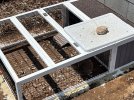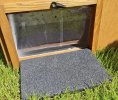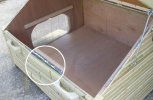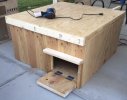emergeartistry
New Member
We took over the care of our tortoise Schmidt a few weeks ago, from a family member who was moving out of the country. It’s wild, we were told she’s either a Sonoran desert tortoise or a Sulcata and we have an appointment coming up with the vet and a tortoise specialist soon to try to get it sorted out.
They know for a fact that she is at least nine years old. They’ve got photos of her going back that far. By that estimate she should be rather large. But she looks like a baby. They kept her in a very small enclosure, and the poor thing is literally only about 6 inches in length.
They did everything else right, she had regular soaks, a very balanced and varied diet mixed w/ lots of local plants (Arizona), enrichment, she had a burrow in her very small area, and access to water regularly, received plenty of UV light and calcium. They said her last vet visit was this past winter and she has no sign of MBD.
That being said, she is incredibly tiny like I said.
So now we have a dilemma and I’m not sure what to do. She is so small for her age that she’s hard to keep track of and very vulnerable to coyotes who can easily hop the fence into backyards in Arizona. I know so many people whose small pet tortoises have been either harmed by them or killed.
So we constructed a coop for her that’s about three times the size of the one that she was in originally, lots more room to roam around, but still not free roaming.
At this point, at 9 or 10 years old, will she even grow larger or is this it for the rest of her life? They couldn’t remember exactly how old she was but like I said they have photos going back at least nine or 10 years so he said his guess is that she is 9 to 11 years old.
Also, now I feel torn, I know that keeping her in the very very small enclosure is likely the thing that stunted her growth, but I’m worried about just giving her free roam of the yard if she’s going to be permanently small, because she’s at such a higher risk of harm from coyotes or bobcats.
The run that she has now is about five or 6 foot long and about four or 5 foot wide with lots of grass and dirt and gravel, and a burrow and a mini soaking pool, and a shaded area. We are in the process of building something even bigger, but this is infinitely larger than what she came to us in and it was pre-assembled, so we’re just using it through the hottest part of the summer so we can construct something larger this fall.
Sorry for the poor quality photo
They know for a fact that she is at least nine years old. They’ve got photos of her going back that far. By that estimate she should be rather large. But she looks like a baby. They kept her in a very small enclosure, and the poor thing is literally only about 6 inches in length.
They did everything else right, she had regular soaks, a very balanced and varied diet mixed w/ lots of local plants (Arizona), enrichment, she had a burrow in her very small area, and access to water regularly, received plenty of UV light and calcium. They said her last vet visit was this past winter and she has no sign of MBD.
That being said, she is incredibly tiny like I said.
So now we have a dilemma and I’m not sure what to do. She is so small for her age that she’s hard to keep track of and very vulnerable to coyotes who can easily hop the fence into backyards in Arizona. I know so many people whose small pet tortoises have been either harmed by them or killed.
So we constructed a coop for her that’s about three times the size of the one that she was in originally, lots more room to roam around, but still not free roaming.
At this point, at 9 or 10 years old, will she even grow larger or is this it for the rest of her life? They couldn’t remember exactly how old she was but like I said they have photos going back at least nine or 10 years so he said his guess is that she is 9 to 11 years old.
Also, now I feel torn, I know that keeping her in the very very small enclosure is likely the thing that stunted her growth, but I’m worried about just giving her free roam of the yard if she’s going to be permanently small, because she’s at such a higher risk of harm from coyotes or bobcats.
The run that she has now is about five or 6 foot long and about four or 5 foot wide with lots of grass and dirt and gravel, and a burrow and a mini soaking pool, and a shaded area. We are in the process of building something even bigger, but this is infinitely larger than what she came to us in and it was pre-assembled, so we’re just using it through the hottest part of the summer so we can construct something larger this fall.
Sorry for the poor quality photo





